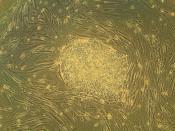II. BACKGROUND ÃÂ÷ What congressional and state legislation has been proposed related to this issue? ÃÂ÷ When? ÃÂ÷ Where? ÃÂ÷ Who proposed it? ÃÂ÷ What Congressional Committee does your issue fall under With the recent, turn of events pertaining to the advances in Human Genetic Engineering, the United States Congress has had to deal with many proposals that relate to the matter. Most of which have had a direct correlation to the focus of stem cell research. There have been five major proposals this year that pertains to genetic alteration on humans. Those bill proposals are H. CON. RES. 17, the Stem Cell Research Act of 2001, the Stem Cell Research for Patient Benefit Act of 2001, the Responsible Stem Cell Research Act of 2001, and the New Century Health Advantage Act.
The bill H. Con. Res. 17 conveys that Congress supports Federal Funding for pluripotent stem cell research. This bill was proposed by Rep.
Carolyn B. Maloney of New York. It was introduced into the House on January 30, 2001. The bill is attempting to obtain vital funding for the research. The bill justifies that it is in no way contradictory to that of the ban on Federal Funding of human embryo research due to the fact that pluriotent stem cells are not and cannot become embryos. It also constitutes that funding for such a project can improve upon research for diseases and ailments that have so far been seen as incurable such as AIDS, Alzheimer's disease, Parkinson's Disease, and spinal cord injury. The bill was referred to the House Committee on Energy and Commerce and then referred to the subcommittee on health on the 14th of February 2001.
The Stem Cell Research Act of 2001 is a bill that proposes, "The Department of Human and Health Services would fund the derivation and use of human pluripotent stem cells."ÃÂ It states an amendment to the Public Health Service Act to "allow the Secretary of Health and Human Services to conduct, support, fund human embryo research to generate embryonic stem cells."ÃÂ Embryos that are of permitted use are "those embryos that otherwise would be discarded that have been donated from in-vitro fertilization clinics with the written informed consent of the progenitors."ÃÂ The research also shall not consequence into the development of embryos. Also, it states that the "research will not result in the cloning of a human being."ÃÂ The Stem Cell Act of 2001 was proposed by Representative Jim McDermott. It was introduced in the House on June 5, 2001 and referred to the House Committee on Energy and Commerce. As of June 18, 2001, it has been referred to the House Subcommittee on Health.
The Stem Cell Research for Patient Benefit Act of 2001 is a bill that proposes the "Director of the National Institutes of Health to: (1) conduct or support research using human pluripotent stem cells from embryos and fetal tissue in accordance with the National Institutes of Health Guidelines for Research Using Human Pluripotent Stem Cells; and (2) study and report to specified congressional committees on stem cells and the effectiveness of such guidelines."ÃÂ It provides a Biomedical Advisory Commision, whose mane goal is to engage in studies and exert advice on bioethical issues that occur in research and the appliance of such research. The bill was proposed by a Representative Diana DeGette. It was introduced to the House on August 2, 2001. It was referred to the House Committee on Energy and Commerce and currently it is being reviewed by the subcommittee on Health.
The Responsible Stem Cell Research Act is a bill that seeks resolution by allowing the Secretary of Human and Health Services to "establish a stem cell donor bank containint stem cells derived from umbilical cord blood, placental tissue, and adult tissues."ÃÂ Those cells would be available for biomedical research and provide an official designation for stem cell donation. The bill also allows for the NIH to receive funding of $30 million for the fiscal year 2002. It also ensures that the NIH recieves proper funding for research in the years 2003 through 2006. The bill was proposed by Senator John E. Ensign. The bill was introduced into the House on August 3, 2001. It was referred to the House Committee on Senate, Health, Education, Labor, and Pensions.
The New Century Health Advantantage Act proposes that the "Director of the NIH employs research using pluripotent stem cells that resulted from human embryos for the purpose of fertility treatment and in excess of the clinical need of the individuals seeking such treatment."ÃÂ The bill repeals the Departments of Labor, Health and Human Services, and Education, and Related Agencies Appropriations Act of 2001 that which prohibits use of funds for research dealing with human embryos. The bill was proposed by Rep Juanita Millender-McDonald. It was introduced to the House on September 5, 2001. It was rederred to the House Committee on Energy and Commerce and is currrently being looked upon by the subcommittee on Health.





